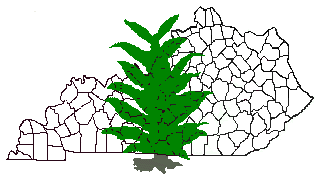

The very high temperatures experienced last week (in excess of 100 F for 6 hours/day on multiple days) greatly reduced the potential for damaging levels of blue mold to develop in the near future over most of the Ohio River Valley region. Consequently, the blue mold status has been downgraded from where it was last week for most areas. County Extension Offices in all counties that had active disease prior to last week's extreme heat, need to update their status reports as soon as new sporulation is observed. If I do not hear from you via email or phone call, I am assuming the disease is not active in your county.
Stressed tobacco plants, high day and high night temperatures, plus dry foliage at night are not conducive for blue mold development. It will take the pathogen several days to recover from the recent hot weather. By the time such happens, if it does, most crops will be beyond the stage they could be seriously damaged by blue mold. However, exceptions exist in communities that received heavy rainfall late last week on crops that were not seriously drought-stressed, because such crops have experienced much cooler and wetter conditions at night. Also, in irrigated crops the risk is much higher than fields without irrigation in drought areas, because temperatures are much cooler in such fields, leaves are wet at night, and tender growth is present. Thus, each grower must assess the risk on a field-by- field basis. Protective fungicide sprays are not needed for most crops, but they are needed in crops growing under conditions conducive to blue mold development in communities under watches.
Statewide drought is a major limiting factor to growth of the tobacco plant, greatly reducing the potential for blue mold to develop. In addition, root diseases are causing major damage to this year's crop.
Status reports by Extension Area or state/region are as follows.
Foliar fungicide sprays, applied at 5-7 day intervals, are recommended for communities under a watch or warning and all irrigated crops in areas under advisory. Follow label directions as to spray volume, fungicide rate, numbers of applications, nozzle arrangements, and days-to-harvest intervals. Acrobat MZ will be the most effective fungicide. Even in areas under watches or warnings, many fields will not warrant sprays because the tobacco is not growing well enough to economically support the cost of a spray program. Crops with a yield potential under 2500 lbs/A are unlikely to benefit economically from a regular spray program with Acrobat MZ. Exceptions would be crops planted to low plant populations, less than 6000 plants/acre, where very lush growth is present. Growers need to be paying particular attention to later planted crops, because large amounts of inoculum can be generated from older crops (without much damage to these) and from suckers.
![]() For current blue mold information, go to the Ky Blue Mold Warning System at:
For current blue mold information, go to the Ky Blue Mold Warning System at:
http://
www.uky.edu/Agriculture/kpn/kyblue/kyblue.htm
 Here are some points that may help you understand
why black shank is worse on plants under stress.
Here are some points that may help you understand
why black shank is worse on plants under stress.
* The causal agent is a facultative saprophyte. Thus, even though the pathogen can directly kill the plant by itself, it will be even more aggressive (pathogenic) when the host plant is stressed, wounded or weakened by other factors.
* Black shank is best thought of as a root rot and not a shank rot. The fungus readily colonizes the rhizoplane and rhizosphere (outer layers of the root and adjacent soil) of the tobacco root, regardless of cultivar. It often enters the epidermal (=superficial) cells of roots and causes limited disease and some feeder-root death, but without causing major damage as long as adequate roots are present to support the plant. This is especially true of less virulent strains.
* Within the same race of this fungus, there is considerable variation in virulence (aggressiveness) among strains. Some strains are weakly virulent while others are highly virulent. Weakly virulent strains, in most seasons, may only cause stunting, but when the plant is under more stress, they can kill the plant. High populations of weak strains can cause great damage, especially when the plants have been stressed. I have often used a boxing analogy to explain this. If we put enough little kids in the ring of the World Champion, he can be defeated by the "weak one".
* The roots of resistant cultivars are colonized at the rhizosphere/rhizoplane levels (outer layers of the root and adjacent soil) to about the same degree as susceptible cultivars. In resistant varieties, the fungus is limited to the cortex as long as the plant is able to resist and keep it confined to this region of the root. However, once the fungus gets into the stele of the root, further tissue invasion is similar to that in susceptible cultivars - it advances freely as tissues are killed in advance of the invading fungus. Root injuries that expose the stele (vascular tissue of the root) allow direct invasion into this area.
Capture of corn earworm (CEW) moths in
pheromone traps has been increasing over the past
two weeks. These moths will be out looking for a
place to lay their eggs. Given the drought
conditions, our corn crop may not be the favored
place. As a result, this pest, also known as the
soybean podworm (SPW), may begin to show up in
bean fields.
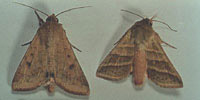
Podworm problems in soybean are very unpredictable in Kentucky. In a normal year economically important infestations will almost always be found in late planted beans and many of these fields will be those double cropped with wheat. This late planting often results in fields where the canopy never closes. So, late planted fields, fields with open canopies, and fields near corn that is drying down would be the very first places to look for this pest.
Podworms seldom feed on soybean leaves. They much prefer pods and flower structures. Therefore, you can not detect the presence of this pest without getting out into the field, and observing the beans where the pods set. Most, importantly, this pest has a very low treatment threshold. Just two SPWs per row-foot warrants a control measure.
Make sure you identify this pest correctly. SPW is often found in a mixed population with fall armyworm (FAW) and green cloverworm (GCW). It is easy to tell the difference between SPW and GCW but not so easy to tell the difference between FAW and SPW, and the thresholds are very different. If you are unsure, first make sure there is pod damage, then get a proper identification. If you can't do it then send some of the wee beasts to the insect ID lab via your county agent.
Soybean podworms 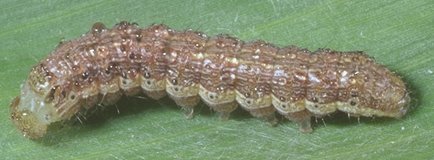 can be very small or up to 1"
in length. The are usually tan to pale green with
several dark stripes down the back. However, color
may be quite variable with some individuals almost
black. They will have three pair of true legs behind
the head, four pair of fleshy legs in the middle of the
body (GCW have only three pair here) an one pair
of fleshy legs at the tail end. FAW usually are
darker than SPW have a strip down the side which
contains some red or pink splotches (SPW don't)
and have an inverted 'Y' on their heads (again SPW
does not have this).
can be very small or up to 1"
in length. The are usually tan to pale green with
several dark stripes down the back. However, color
may be quite variable with some individuals almost
black. They will have three pair of true legs behind
the head, four pair of fleshy legs in the middle of the
body (GCW have only three pair here) an one pair
of fleshy legs at the tail end. FAW usually are
darker than SPW have a strip down the side which
contains some red or pink splotches (SPW don't)
and have an inverted 'Y' on their heads (again SPW
does not have this).
Green Cloverworm

Fall Armyworm

It is important to know the difference between these pests. Control thresholds are 2 worms per row-foot for SPW, populations of GCW will generally need to be greater than 20 per row-foot to be important. FAW controls are based on leaf defoliation, but the populations will be considerably greater than 2 per row-foot to make a difference.
Basically in Kentucky, there are three insect pests that can directly attack developing sweet corn ears. Each of these can directly ruin the marketability of an ear. Two of these pests, corn earworm and the European corn borer, can attack throughout the season, while the fall armyworm usually is associated with later maturing fields. Despite intense insect pressure, corn producers have the necessary tools to produce near damage-free sweet corn.
In some years the corn earworm can infest nearly 100 percent of the ears in unprotected corn fields. Eggs are laid on fresh corn silks, and upon hatching the larvae migrate into the tip of the ear where they feed on silks and developing kernels. So how do the earworm moths know how to lay there eggs such that there is exactly one larva per ear? They don't. Many eggs may be laid per ear, but the larvae are aggressive and cannibalistic. Rarely does more than one earworm occupy the ear tip.
 Earworms are variable in color, but they have a
brown head without markings and numerous
microscopic spines covering their body. Earworms
spend a relatively short period of their life feeding
in a site that can receive an adequate insecticide
application. A preventive program, especially on
late season corn, is necessary to ensure that
damaged ears are at a minimum. Following hatch,
the small larvae often eat the egg shell before
beginning to feed on the silk. A preventive program
against corn earworms may begin when 10% of the
ears are silked. Repeated sprays at three to five day
intervals until 90% of the silks have wilted should
give a high percentage or worm-free ears during
early and midseason. Control is more difficult late
in the season. Even shortening spray intervals may
produce only 90% clean ears. Spray solution should
be driven deep into the silks. Corn hybrids having a
long, tight-fitting shuck appear to suffer less
damage than those with loose shucks.
Earworms are variable in color, but they have a
brown head without markings and numerous
microscopic spines covering their body. Earworms
spend a relatively short period of their life feeding
in a site that can receive an adequate insecticide
application. A preventive program, especially on
late season corn, is necessary to ensure that
damaged ears are at a minimum. Following hatch,
the small larvae often eat the egg shell before
beginning to feed on the silk. A preventive program
against corn earworms may begin when 10% of the
ears are silked. Repeated sprays at three to five day
intervals until 90% of the silks have wilted should
give a high percentage or worm-free ears during
early and midseason. Control is more difficult late
in the season. Even shortening spray intervals may
produce only 90% clean ears. Spray solution should
be driven deep into the silks. Corn hybrids having a
long, tight-fitting shuck appear to suffer less
damage than those with loose shucks.
The second generation of European corn borers presents can be a serious challenge for sweet corn growers. First generation larvae were generally concentrated in the whorl, which provided a good collection funnel for the insecticide spray or granules. On tasseled corn, the second generation borers are dispersed over the plant and protected behind leaf sheaths and in axils. They don't restrict their attack just to the tip of the ear. In this situation, plant coverage with the foliar spray is very important. If borer populations are high, it is possible that two or more sprays may be necessary to achieve satisfactory control.
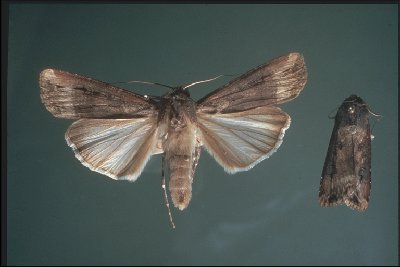
Fall armyworm moths migrate northward from the Gulf states each year and generally arrive in Kentucky about mid-July. Infestations are most likely to occur on corn that is knee to waist high in July. Late planted sweet corn should be watched closely for fall armyworm activity. The larvae or worms feed on leaves and in the whorl. They will enter the ear and cause damage similar to that from the corn earworm.
 The larvae are smooth and green to black with three
thin yellow lines down the back. A dark stripe and a
wavy yellow stripe runs along each side. Larvae
have a dark head with a white inverted "Y".
The larvae are smooth and green to black with three
thin yellow lines down the back. A dark stripe and a
wavy yellow stripe runs along each side. Larvae
have a dark head with a white inverted "Y".
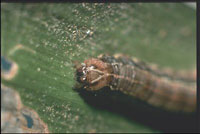 Repeated spray application may be necessary if
fields become reinfested. Thorough spray coverage
with insecticides recommended against corn borers
should provide satisfactory control. Applications
should be made before worms enter the ear.
Generally, corn earworm sprays applied while the
silks are fresh control fall armyworm.
Repeated spray application may be necessary if
fields become reinfested. Thorough spray coverage
with insecticides recommended against corn borers
should provide satisfactory control. Applications
should be made before worms enter the ear.
Generally, corn earworm sprays applied while the
silks are fresh control fall armyworm.
As a group, lady beetles are extremely beneficial in forests, agricultural fields, and in the urban landscape. They perform an important role by consuming aphids, scales, mites, insect eggs, and other plant pests. Lady beetles belong to the insect family Coccinellidae. Many are familiar with one pesty Coccinellid, the Mexican bean beetle, a lady beetle that feeds on beans rather than other insects.

Last week another lady beetle that would rather feed on plants than insects was reported in the state. It is the Squash beetle, Epilachna borealis. The squash beetle feeds on the foliage of squash, pumpkins and gourds. The squash beetle is similar in appearance to the Mexican bean beetle, except the squash beetle has 7 rather than 8 spots on each wing cover, the spots are larger in size, and the body is generally more shiny.
This insect does not do much damage relative to that caused by the squash bug or the squash vine borer. It has an interesting behavior of circling the leaf before beginning to feed.
 Black and redheaded blister beetles have been
feeding extensively on tomatoes. Sometimes called
the "old fashioned potato bug", these slender
beetles with soft wing covers feed on a wide variety
of crops and flowers. They tend to congregate in
clusters on plants and can completely strip the
foliage. Stomach poison insecticides, such as Sevin,
can provide good control.
Black and redheaded blister beetles have been
feeding extensively on tomatoes. Sometimes called
the "old fashioned potato bug", these slender
beetles with soft wing covers feed on a wide variety
of crops and flowers. They tend to congregate in
clusters on plants and can completely strip the
foliage. Stomach poison insecticides, such as Sevin,
can provide good control.

This summer's dry weather has created difficult times for mature landscape trees in many areas of Kentucky. The problem is compounded by the fact that many areas endured dry weather most of the second half of last growing season as well. Branch breakage from periodic high winds have left wounds that allow ingress of weak parasites and even aggressive saprophytes that are often indicators of the final stages of tree decline. The fungus Hypoxylon atropunctatum and to a lesser extent relatives, H. mediterraneum, and H. punctulatum, are fungi that attack injured oaks and other trees growing in stressful conditions.
Hypoxylon canker is commonly seen on oaks as patches of brown, gray, silvery gray or black fungal stromata in the cambial zone of affected trees. These smooth, hard patches are revealed when the tree bark is loosened and sloughs off the affected trunk or limb. By the time the patches of fungal stromata are revealed, the fungus has decayed much of the adjacent inner bark and outer sapwood. Discoloration and decay are often accompanied by black zone lines in the sapwood, similar to that seen for other sapwood decays.
Hypoxylon fungi are quick to colonize weakened bark and wood, and stromata may develop within a few months after infection. Oaks and other trees are very quickly attacked because it seems that in some instances, the fungus may already be present as a latent colonist of even healthy trees. Injuries of any kind, and now warm, dry weather, favor the fungus and rapid decline can be expected. Tree trunks and major limbs with Hypoxylon canker and dieback should be considered hazardous and need to be removed where they represent a danger to people and property.
Look for Hypoxylon canker and dieback on all oaks, sycamore, linden, hickory, maple, beech, dogwood, hornbeam, elm, and willow. Although in some cases, the fungus is pretty much saprophytic, attacking trees already declining, the fungal stromata are sure indicators that the tree or tree parts will not recover. These fungi are most active under our warm growing conditions; some of them are thought to compete with the oak wilt fungus, a primary and highly destructive pathogen of oak, for nutrients, thus suppressing this more destructive disease. This might account for the relatively minor role of oak wilt disease in Kentucky.
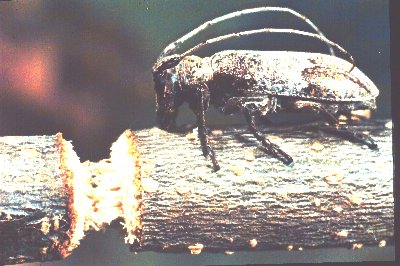 Female twig girdlers are laying eggs in lateral or
terminal twigs of many trees, including hickory,
pecan, oak, and many others. After depositing a
single egg, the female chews a continuous notch
around the twig, girdling it. These twigs, usually
over a foot long, die quickly and fall to the ground.
The egg in the broken twig hatches and the legless
white larva feeds some before winter. Development
resumes in the spring and the adult emerges in early
fall. Sanitation is the key to managing this pest.
Pick up and destroy the fallen twig to kill the
developing generation.
Female twig girdlers are laying eggs in lateral or
terminal twigs of many trees, including hickory,
pecan, oak, and many others. After depositing a
single egg, the female chews a continuous notch
around the twig, girdling it. These twigs, usually
over a foot long, die quickly and fall to the ground.
The egg in the broken twig hatches and the legless
white larva feeds some before winter. Development
resumes in the spring and the adult emerges in early
fall. Sanitation is the key to managing this pest.
Pick up and destroy the fallen twig to kill the
developing generation.

Numerous calls are received each year about spiders. Typically, the caller wants to know if the spider they've seen is dangerous, and what if anything should be done in terms of control.
Many different kinds of spiders live in and around buildings. Some, such as the house, cellar, and garden spiders, construct webs to help entrap their prey. Others, like the wolf spiders, are free-roaming and make no webs. The vast majority of spiders are harmless, and in fact are beneficial, because they prey upon flies, crickets and other insects. They generally will not attempt to bite humans unless held or accidentally trapped. Moreover, the majority of spiders have fangs too small or too weak to puncture human skin. Of the hundreds of species found in Kentucky, only the black widow and brown recluse are dangerous. Fortunately, both are relatively uncommon, and have markings which can be used to distinguish them from other non-threatening species.
Brown Recluse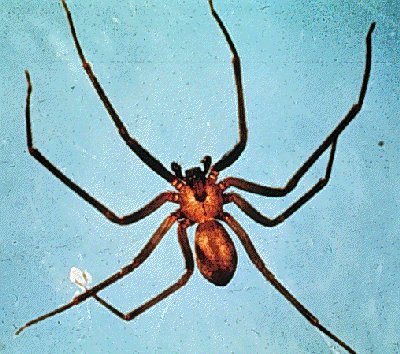
Black Widow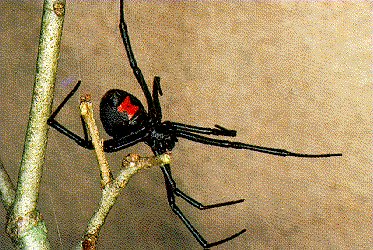
Even though most spiders are harmless, few people are willing to tolerate them inside the home. Their unsightly webbing and fecal spots further negate the beneficial aspects of spiders to most homeowners. This column provides practical tips on spider control for concerned clients.
General Control Measures (all species)
1. Routine, thorough house cleaning is the most effective way to eliminate spiders and discourage their return. A vacuum cleaner and broom are the householder's most useful tools for removing spiders, webs, and egg sacs.
2. Spiders prefer quiet, undisturbed areas such as closets, garages, basements, and attics. Reducing clutter in these areas makes them less attractive to spiders.
3. Large numbers of spiders often congregate outdoors around the perimeter of structures. Migration indoors can be reduced by moving firewood, building materials, and debris away from the foundation. Shrubs, vines and tree limbs should be clipped back from the side of the building. Maintaining a vegetation-free zone next to the house also lowers the moisture content of the foundation and siding, making them less attractive to termites, carpenter ants, rodents and decay.
4. Install tight-fitting window screens and door sweeps to exclude spiders and other insects. Inspect and clean behind outdoor window shutters, and inside the orifices of gas barbecue grills.
5. Consider installing yellow or sodium vapor light bulbs at outside entrances. These lights are less attractive than incandescent bulbs to night-flying insects which, in turn, attract spiders.
6. To further reduce spider entry from outdoors, insecticides can be applied as a "barrier treatment" around the base of the foundation. Pay particular attention to door thresholds, garage and crawl space entrances, including foundation vents. Sevin, Dursban, or any of the synthetic pyrethroids, e.g., Spectracide Bug Stop (tralomethrin), Ortho Home Defense System (bifenthrin) are effective, but may need to be reapplied periodically throughout the summer.
Brown Recluse/Black Widow Both of these spiders are potential health threats. They are timid, however, and will only bite in response to the threat of being injured. Most bites occur while putting on a shoe or piece of clothing in which a spider has hidden, or while unpacking boxes, sorting through clutter, etc.
The female black widow is about 1/2-inch long, shiny black and usually has a red hourglass mark on the underside of the abdomen. In some varieties the hourglass mark may be reduced to two separate spots. Most adult brown recluse spiders are about the size of a dime to a quarter with legs extended. Coloration ranges from tan to dark brown, with the abdomen often darker than the rest of the body. The feature that most distinguishes the brown recluse from many other harmless spiders is a somewhat darker violin-shaped marking on the top of the leg- bearing section of the body. The neck of the violin "silhouette" points toward the rear (abdomen) of the spider. Although each species has distinctive markings, a "spider is a spider" to most people. Concerned homeowners or victims of spider bites should be advised to bring the specimen in for confirmation.
Spider bites are difficult to diagnose, even by physicians. Black widow venom is a nerve toxin and its effects are rapid. The victim suffers painful rigidity of the abdomen and usually tightness of the chest. Victims should seek medical attention promptly. The bite of the brown recluse is usually painless until 3 to 8 hours later when it may become red, swollen and tender. Later the area around the bite site may develop into an ulcerous sore from « to 10 inches in diameter. Healing often requires a month or longer, and the victim may be left with a deep scar. Prompt medical attention can reduce the extent of ulceration and further complications. Not all brown recluse bites result in ulcerations and scarring.
The brown recluse may be found living indoors or outdoors. Black widows are more often encountered outdoors. Thorough inspection of cracks, corners, and other dark, undisturbed areas with a bright flashlight is an essential first step in determining the location and extent of infestation. Indoors, pay particular attention to basements, attics, crawl spaces, closets, under/behind beds and furniture, inside shoes, boxes of stored items, and between hanging clothing. Brown recluse spiders also may be found living above suspended ceilings, behind baseboards, and inside ductwork or floor/ceiling registers. Another way to detect infestations in these areas is to install glueboards or sticky traps. Designed to capture mice and cockroaches, these devices can be purchased at grocery or farm supply stores. Placed flush along walls and in corners, they are useful monitoring tools and will also capture large numbers of spiders.
Brown recluse and black widow spiders also live outdoors in barns, utility sheds, woodpiles, and underneath lumber, rocks, and accumulated debris. To avoid being bitten, wear work gloves when inspecting inside boxes or when moving stored items.
Each of the management tips (1-6) noted above for spiders in general are also useful for the black widow and brown recluse. Removal of unnecessary clutter is especially helpful in making areas unattractive to these pests. Indoor infestations of brown recluse and black widow also warrant treatment with insecticides. Insecticides should be applied into areas where spiders are living, making an attempt to contact as many spiders and webs as possible with the treatment. Most household insecticides with spiders listed on the label will kill spiders provided the spider is treated directly. Spot treatment with synthetic pyrethroids such as those mentioned earlier are especially effective. In attics, storage sheds, and other inaccessible or cluttered areas, total-release foggers (e.g., Raid Max, containing cylathrin) will have a better chance of contacting spiders that are hidden.
Severe infestations of brown recluse or black widow spiders require specialized skills, persistence and equipment to eradicate. In these situations, it would be prudent to call a professional pest control operator.
Diagnoses of corn diseases this week have included gray leaf spot and maize dwarf mosaic virus; on soybean we have seen soybean cyst nematode and Fusarium stem rot. On tobacco we are still seeing black shank and soreshin--often in combination--as well as scattered blue mold, target spot, Fusarium wilt, root knot nematode, tobacco mosaic virus, tobacco streak virus and tomato spotted wilt virus.
In fruits we have seen Verticillium wilt on blackberry; black rot on grape; bitter rot on apple; bacterial blight (Xanthomonas) on walnut; and bacterial canker, scab and brown rot on peach. On vegetables we have seen black rot on cabbage; bacterial spot on pepper; bacterial wilt on cantaloupe; bacterial canker, bacterial spot, Fusarium wilt, early blight and stinkbug damage on tomato.
Diseases of ornamentals diagnosed this week have included Rhizoctonia root and stem rot on chrysanthemum; anthracnose, brown patch and Nigrospora blight on turf; and Botryodiplodia canker on elm.

| UKREC-Princeton, KY, July 23 - 30 | |
| European Corn Borer | 3 |
| Corn Earworm | 61 |
| True Armyworm | 12 |
| Southwestern Corn Borer | 363 |
| Fall Armyworm | 3 |
By Lee Townsend
Click here for the Training and Testing Schedule on the Pesticide Applicator Training web site
Lee Townsend
Extension Entomologist